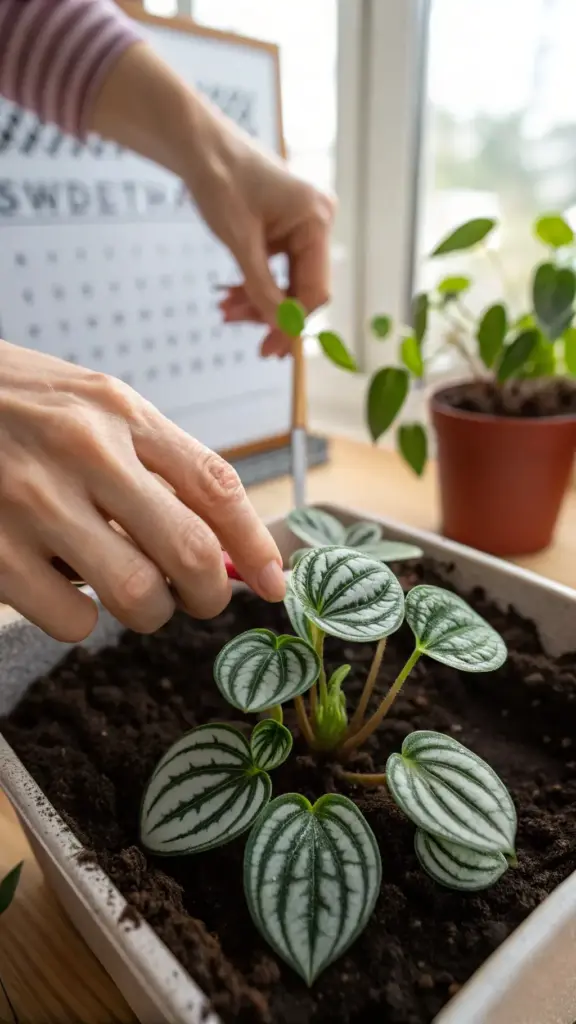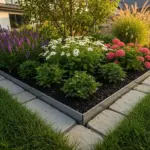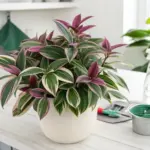3. Watering on a Rigid Schedule Instead of Reading Plant Cues

I used to be obsessed with schedules. Every Sunday at 9 AM, I’d march around my apartment with my watering can like some kind of plant drill sergeant.
“Water day!” I’d announce to my watermelon peperomias, whether they needed it or not.
Spoiler alert: they usually didn’t.
Why “Water Every Sunday” is Plant Murder
Here’s the brutal truth – I killed more plants with my rigid watering schedule than I ever did from forgetting to water them. My Sunday routine was basically plant torture disguised as good care.
Plants don’t live by our human calendars.
Your watermelon peperomia doesn’t know it’s Sunday, and it definitely doesn’t care about your color-coded planner. Some weeks it needs water on Tuesday, other weeks it can go two Sundays without a drink.
Scheduled watering ignores everything that actually matters – soil moisture, humidity, temperature, and what your plant is trying to tell you.
The Finger Test That Changed Everything
The day I learned the finger test was the day I became a decent plant parent. It’s embarrassingly simple, but it works.
Stick your finger about 2 inches deep into the soil. If it’s dry, water time.
If it’s still moist? Walk away and check again in a few days.
I felt so dumb when I realized how easy this was. All those plants I’d drowned because “it was watering day” could’ve been saved with a simple finger poke.
The soil doesn’t lie.
Seasonal Changes That Blew My Mind
Winter hit and suddenly my Sunday watering routine became a death sentence. My watermelon peperomias were staying wet for weeks.
Winter watering is completely different from summer watering. Lower light, cooler temperatures, and less growth means way less water needed.
In summer, my plants might need water every 7-10 days. Winter? Sometimes 3-4 weeks between waterings.
I learned this after watching several plants develop root rot during my first winter as a plant parent. The soil was staying soggy because the plants just weren’t using the water.
Humidity’s Secret Role in Watering
Living in different apartments taught me that humidity levels change everything about watering frequency. My old place was dry as a desert – plants needed water constantly.
My current apartment stays pretty humid, especially in the bathroom where I keep some of my tropical plants.
High humidity means slower water evaporation from soil. Low humidity means faster drying and more frequent watering needs.
I started paying attention to my skin – if I needed extra lotion, my plants probably needed extra water too.
Creating a Flexible Routine That Actually Works
Instead of rigid schedules, I developed what I call “check-in days.” Every few days, I do a quick soil moisture test on all my plants.
Some get water, some don’t. It’s that simple.
I keep a small notebook where I jot down when each plant actually gets watered. Patterns emerge, but they’re based on the plant’s needs, not my calendar.
For busy weeks, I focus on the finger test for my most sensitive plants first. Watermelon peperomias are pretty forgiving, so they can wait if needed.
The Reality Check Method
Now I ask myself three questions before watering: Is the soil dry? Does the plant look thirsty? Has it been unusually hot or cold lately?
If any answer is “no,” I skip watering that plant.
Plant cues are way more reliable than any schedule. Slightly droopy leaves, dry soil, or lighter-weight pots are all better indicators than your phone reminder.
Building Intuition Over Time
The weird thing is, after ditching my rigid schedule, I actually became more consistent with plant care. I started really looking at my plants instead of just going through the motions.
Reading plant cues becomes second nature once you start paying attention. Your watermelon peperomia will literally tell you what it needs if you just listen.
Trust your plants, not your planner.
Ready for the next watering disaster that’s hiding in plain sight? Click “next” to learn why that gorgeous decorative pot you love might be secretly murdering your plants – and how to fix it without sacrificing style.









GIPHY App Key not set. Please check settings